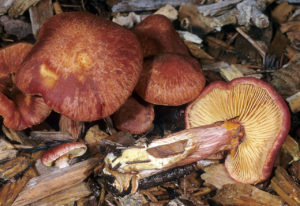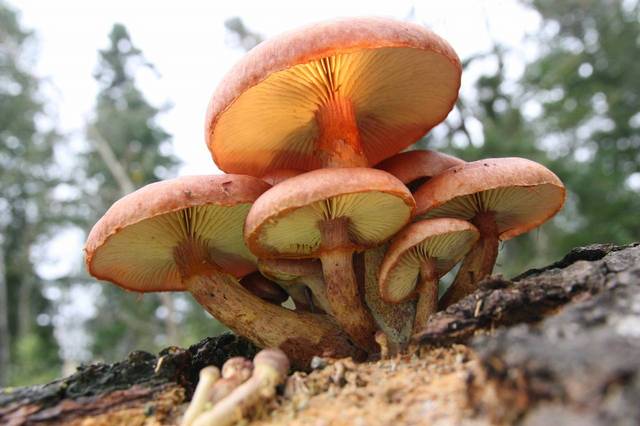Gymnopilus luteofolius was originally described by Charles Peck in 1875 when it was named Agaricus luteofolius. It was then re-named in 1887 by Pier Saccardo as Pholiota luteofolius before gaining its current name in 1951 by Rolf Singer. It is widely distributed and often found in dense clusters growing on deadwood. In East America it grows from Summer until Fall, and on the West and North coast of America, it can also be found in Winter. It can be quite striking in appearance and is also known as yellow-gilled gymnopilus and rarely the golden-gilled gymnopilus. This mushroom can be distinguished by its very bitter taste, and the color of the flesh turns purple or pink when sliced. Gymnopilus luteofolius contains psilocybin, a naturally occurring psychedelic. Once administered psilocybin is rapidly metabolized into a drug that acts on the serotonin receptors in the brain, this may result in visual and auditory hallucinations, a distorted sense of time, feelings of euphoria and spiritual experiences. The effects will be dose-dependent, and the level of psilocybin found in Gymnopilus luteofolius has not been documented.
Gymnopilus Luteofolius Identification and Description
Cap: 2 to 12cm in diameter; convex becoming flattened with age. Incurved margin becoming decurved with age. Flesh thinner at the margin. Small fibrillose scale covering; variable colors: purple-red fading to yellow or pink in places. May develop green (sometimes blue) spots 
Gills: Notched to adnate. Pale yellow turning darker with maturity; eventually, rusty brown as spores develop. Young gills covered by thin and partial veil.
Stem: 3 to 10cm tall; 5mm thick. Usually equal but maybe larger at same. Flimsy ring. Same color as cap.
Smell: Mild and not distinctive.
Taste: Very bitter.
Spores: Warted spores; elliptical
Spore color: Rusty brown to orangey brown.
Edibility: Reports are that it is hallucinogenic if eaten.
Habitat: Saprotrophic. Grows on woodchips, hardwoods and conifers; can be found in dense clusters. Summer to Winter, depending on location. Distributed widely in North America. Found in Eastern and Western areas also.
Scientific classification: Phylum: Basidomycota; Class: Agaricomycetes; Order: Agaricales; Family: Hymenogastraceae; Genus: Gymnopilus and Species: luteofolius.
Gymnopilus Luteofolius Look-Alikes
Gymnopilus luteofolius may be mistaken for Tricholomopsis rutilans as they are similar in colour and both grow on wood. Tricholomopsis rutilans has a white spore print when compared to the orange-brown spore print of Gymnopilus luteofolius.
Gymnopilus Luteofolius Benefits
There is no scientific evidence to support any benefits for Gymnopilus luteofolius.
Gymnopilus Luteofolius Dosage
There is no recommended dosage for this mushroom. There are mixed reports from users with some suggesting large amounts of Gymnopilus luteofolius need to be eaten to reach the desired effect, in contrast only a small amount may be necessary. The psychoactive substance psilocybin would need to be present to produce hallucinations.
With that being said, if you want to try and find a dose that works for you, check out our general magic mushroom dosage guide. You can also try out our magic mushroom dosage calculator where you can choose between six dosage levels, including microdose and heroic dose.
Popular methods of consumption for Gymnopilus luteofolius include Lemon Tek and Shroom Tea.
Gymnopilus Luteofolius Toxicity, Safety & Side Effects
Psilocybin may cause sickness or panic attacks when taken in the form of mushrooms depending on the amount consumed. There are no reports of toxicity levels for Gymnopilus luteofolius therefore if pregnant or breastfeeding, it should be avoided. Seek the advice of a professional mycologist before eating to ensure that the mushroom has been correctly identified.
References:
http://biology.burke.washington.edu/herbarium/imagecollection/taxon.php?Taxon=Gymnopilus%20luteofolius
https://www.ncbi.nlm.nih.gov/Taxonomy/Browser/wwwtax.cgi?lvl=0&id=167109

My name is Austin Collins.
I've dedicated my life to Mushrooms.
I believe Mushrooms are the best kept secret when it comes to health and well being.
For that reason, I would like to share a company with you that in my opinion makes the best mushroom products on the market.
The company is called Noomadic Herbals, my favorite supplement they make is called "Mushroom Total".
I take their products every day and they have helped me think better and have more energy. Give them a try.
-Austin




Awesome article ! I’m not sure that what I found is gymnopolus. It’s April , it was growing on a dead cut tree , it was in small tight clusters and the young ones have yellow hills . But I love on the east coast . I’m worried it may be deadly galerina .